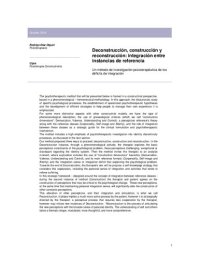
Ebook: Deconstrucción, construcción y reconstrucción: integración entre instancias de referencia
Author: Rodrigo Díaz Olguín
The psychotherapeutic method that will be presented below is framed in a constructivist perspective,
based in a phenomenological – hermeneutical methodology. In this approach, the idiosyncratic study
of specific psychological processes, the establishment of operational psychotherapeutic hypotheses
and the development of efficient strategies to help people to manage their own experience it is
emphasized.
For some more distinctive aspects with other constructivist models, we have the type of
phenomenological description, the use of gnoseological criterias (which we call "construction
dimensions": Demarcation, Valence, Understanding and Control), a perceptions reference's theory
along with the reference classes (Corporeality, Self-image and Alterity), and the role of integration
between these classes as a strategic guide for the clinical formulation and psychotherapeutic
intervention.
The method includes a high emphasis of psychotherapeutic investigation into identity discontinuity
processes, as discussed in the next section.
Our method proposed three ways to proceed: deconstruction, construction and reconstruction. In the
Deconstruction instance, through a phenomenological attitude, the therapist explores the basic
perceptions constituents of the psychological problem, those perceptions challenging, exceptional or
discrepant regarding the identity system. Then the method invites the therapist to an analysis
moment, where exploration includes the use of “construction dimensions” heuristics (Demarcation,
Valence, Understanding and Control), and its main reference formats (Corporeality, Self-image and
Alterity) and the integration sense or integration deficit that explaining the psychological problem.
Towards the end of Deconstruction, the therapist’s aim will be propose a self-knowledge strategy that
considers this explanation, including the personal sense of integration and activities that tends to
relieve suffering.
In this strategic framework - designed around the concept of integration between reference classes -
during the second instance of method (Construction) the therapist and patient agrees on the
construction of perceptions that may be critical to the psychological change. These new perceptions,
at the same time that maintaining personal integration sense, will significantly alter the construction of
other constants perceptions.
This alteration of other perceptions, and their integration and articulation, is what we call
Reconstruction. It phase implies a much more active process by the patient, however it is strategically
directed by the therapist: a perceptual process that requires less cooperation by the therapist,
however may initiate new instances of Deconstruction. Reconstruction is the process of articulating
the new perceptions with the broader sense of personal identity. The understanding of self and others
takes a thematic shape, modulated, more thoughtful, and more comprehensive.
based in a phenomenological – hermeneutical methodology. In this approach, the idiosyncratic study
of specific psychological processes, the establishment of operational psychotherapeutic hypotheses
and the development of efficient strategies to help people to manage their own experience it is
emphasized.
For some more distinctive aspects with other constructivist models, we have the type of
phenomenological description, the use of gnoseological criterias (which we call "construction
dimensions": Demarcation, Valence, Understanding and Control), a perceptions reference's theory
along with the reference classes (Corporeality, Self-image and Alterity), and the role of integration
between these classes as a strategic guide for the clinical formulation and psychotherapeutic
intervention.
The method includes a high emphasis of psychotherapeutic investigation into identity discontinuity
processes, as discussed in the next section.
Our method proposed three ways to proceed: deconstruction, construction and reconstruction. In the
Deconstruction instance, through a phenomenological attitude, the therapist explores the basic
perceptions constituents of the psychological problem, those perceptions challenging, exceptional or
discrepant regarding the identity system. Then the method invites the therapist to an analysis
moment, where exploration includes the use of “construction dimensions” heuristics (Demarcation,
Valence, Understanding and Control), and its main reference formats (Corporeality, Self-image and
Alterity) and the integration sense or integration deficit that explaining the psychological problem.
Towards the end of Deconstruction, the therapist’s aim will be propose a self-knowledge strategy that
considers this explanation, including the personal sense of integration and activities that tends to
relieve suffering.
In this strategic framework - designed around the concept of integration between reference classes -
during the second instance of method (Construction) the therapist and patient agrees on the
construction of perceptions that may be critical to the psychological change. These new perceptions,
at the same time that maintaining personal integration sense, will significantly alter the construction of
other constants perceptions.
This alteration of other perceptions, and their integration and articulation, is what we call
Reconstruction. It phase implies a much more active process by the patient, however it is strategically
directed by the therapist: a perceptual process that requires less cooperation by the therapist,
however may initiate new instances of Deconstruction. Reconstruction is the process of articulating
the new perceptions with the broader sense of personal identity. The understanding of self and others
takes a thematic shape, modulated, more thoughtful, and more comprehensive.
Download the book Deconstrucción, construcción y reconstrucción: integración entre instancias de referencia for free or read online
Continue reading on any device:

Last viewed books
Related books
{related-news}
Comments (0)